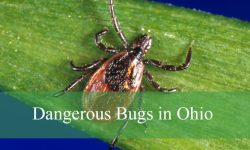Moths in North Carolina form a diverse and fascinating group of insects. From large, colorful species to smaller, more subtle ones, the state hosts a wide variety of moths. Exploring forests, gardens, or even backyards offers many opportunities to encounter these unique creatures.
This guide covers 28 common moths in North Carolina, featuring pictures and clear identification tips. Learn to recognize each species by their distinctive colors, wing patterns, and behaviors. Gaining this knowledge helps deepen appreciation for their role in local ecosystems.
For beginners and experienced nature lovers alike, this article provides useful information to better understand moths in North Carolina. Discover which species are most frequently seen and uncover interesting facts about their habitats and life cycles.
Common Moths Found in North Carolina
Luna Moth (Actias luna)
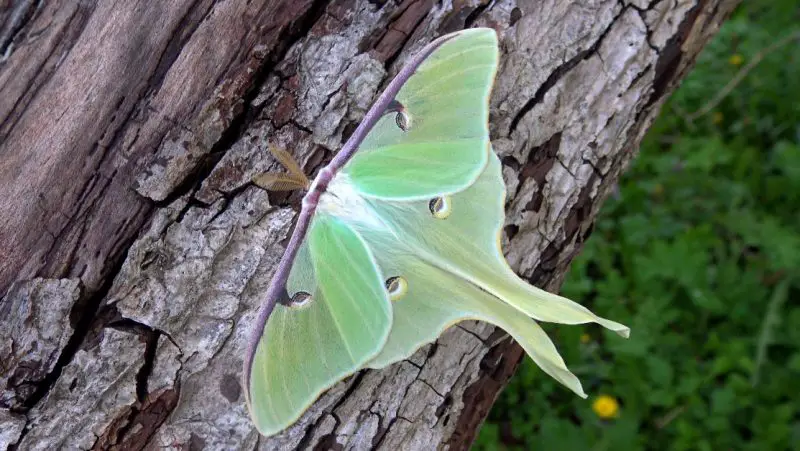
The Luna Moth is one of the most iconic and visually striking moths in North Carolina. With its pale green wings, long sweeping tails, and crescent-shaped hindwing extensions, it is instantly recognizable. Adults have a wingspan ranging from 3 to 4.5 inches, making them among the largest moths in North America. Their wings are translucent with eyespots on each forewing that serve to confuse predators.
This moth is primarily nocturnal and does not feed as an adult, living only about a week. Its main goal is reproduction, and it relies on pheromones to attract mates during the night. The males have large, feathery antennae used to detect these chemical signals. Luna Moths are seen most often from late spring through summer, especially around wooded areas with abundant host trees.
The caterpillars feed on a variety of deciduous trees such as hickory, walnut, sweet gum, and birch. They thrive in deciduous hardwood forests and are particularly common in undisturbed or lightly managed woodlands. In North Carolina, the Luna Moth is widespread, especially in the Piedmont and Mountain regions, where mature forests provide ideal conditions for larval development.
Rosy Maple Moth (Dryocampa rubicunda)

The Rosy Maple Moth is a small but brilliantly colored species known for its cotton-candy-like appearance. Its wings are a vibrant mix of pink and yellow, with the shades varying slightly depending on the individual. Adults have a wingspan between 1.25 and 2 inches. The fuzzy pink body and colorful forewings make this moth stand out among eastern U.S. species.
Active from late spring through early fall, Rosy Maple Moths are frequently seen near porch lights and forest edges. While they are nocturnal, they sometimes remain visible on tree trunks during the day. Adults do not feed, focusing their short lives on reproduction. Their coloration may serve as camouflage among red maple samaras or simply act as a warning display.
As the name suggests, the larvae primarily feed on maple trees, particularly red and silver maples. They may also use sugar maples and occasionally oak. These moths are common throughout North Carolina, especially in suburban neighborhoods, city parks, and forested areas with ample maple trees. The Piedmont and Coastal Plain regions are especially favorable for their host plant availability.
Polyphemus Moth (Antheraea polyphemus)
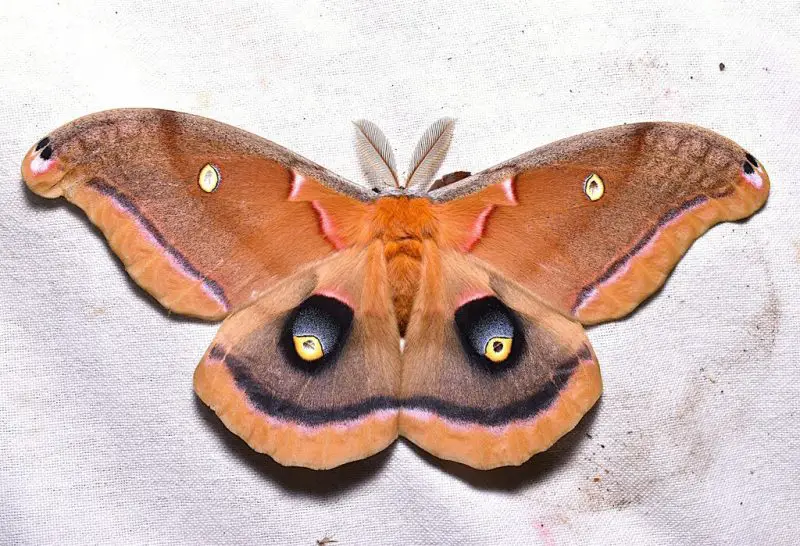
The Polyphemus Moth is a massive and impressive species, known for its rich brown coloration and large eyespots on its hindwings. The wingspan can reach up to 6 inches, making it one of the largest moths in North Carolina. The hindwings feature prominent, transparent “eye” spots, bordered in yellow and black, which are used to startle potential predators.
This moth is primarily active during the warmer months and is seen from late spring through early fall. Like many saturniid moths, adults do not feed and live only a few days. They are nocturnal and attracted to lights, often seen near residential or wooded areas in the evening. Males can be distinguished by their bushy antennae used to detect female pheromones over long distances.
The caterpillars feed on a wide variety of host plants including oak, maple, birch, willow, and beech. They are most commonly found in mixed deciduous forests and wooded urban parks. In North Carolina, the Polyphemus Moth is distributed throughout the state, with notable populations in forested areas of the Mountains and Piedmont, where broadleaf trees are plentiful.
Io Moth (Automeris io)
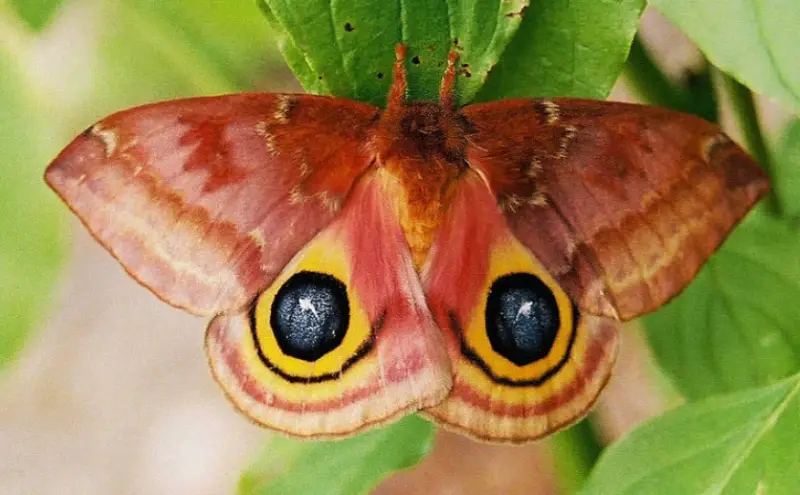
The Io Moth is famous for its dramatic hindwing eyespots, which are used to startle predators when the moth is disturbed. Males are typically bright yellow with brown markings, while females are more subdued in color, often appearing brownish or rusty orange. The hindwings have large black and blue “eye” markings, giving the moth a fierce appearance when threatened.
Io Moths are mainly active in late spring and summer. Adults are nocturnal and attracted to lights, and they live for only about a week. Mating occurs at night, and females lay eggs in clusters on the undersides of leaves. The males are quick flyers and use their feathery antennae to locate females by scent.
The caterpillars are bright green and covered in venomous spines that can cause a painful sting or rash when touched. They feed on a wide range of host plants, including blackberry, corn, roses, willow, and various legumes. Io Moths are common across North Carolina, especially in open woodlands, meadows, and fields near shrubby vegetation. They’re frequently spotted in the Piedmont and Coastal Plain regions.
Fall Webworm Moth (Hyphantria cunea)
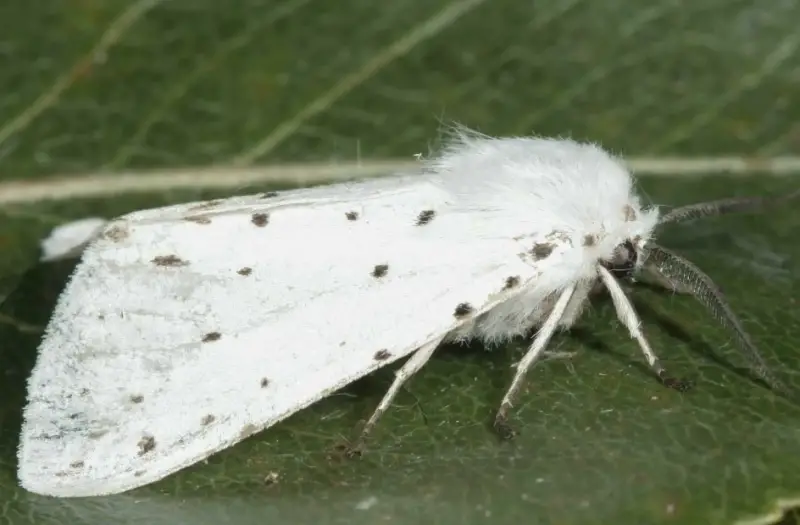
The Fall Webworm Moth is a white, medium-sized moth that becomes especially noticeable in late summer and early fall due to the large silken webs its larvae build in trees. Adults have a wingspan of about 1 to 1.5 inches and are typically pure white, though in some regions they may have small black spots. They are not flashy, but their seasonal presence is unmistakable.
Adult moths are active from spring through fall, with multiple generations per year in southern climates like North Carolina. The larvae are social and spin conspicuous silk nests at the ends of branches, where they feed on the foliage within. These webs can grow large and unsightly, but rarely cause serious harm to healthy trees.
The caterpillars feed on over 100 species of deciduous trees, including walnut, pecan, hickory, cherry, and elm. They prefer open, sunny areas and are especially common along roadsides, woodland edges, and suburban landscapes. In North Carolina, Fall Webworms are widespread and often seen in all regions—from the Mountains to the Coastal Plain—where deciduous trees are abundant.
American Dagger Moth (Acronicta americana)

The American Dagger Moth is a medium-sized, fuzzy gray moth with subtle dark markings on its forewings and a wingspan of about 2 to 2.5 inches. Though the adult is relatively unassuming in appearance, its caterpillar is one of the most recognizable in the eastern U.S. The larvae are bright yellow or greenish with long, black, hair-like setae (bristles) that can cause skin irritation in humans.
Adults are nocturnal and most active during late spring through early fall. They are attracted to lights at night and can be found resting on tree trunks or siding during the day. While the moths themselves pose no danger, the caterpillars should not be handled due to their urticating hairs that may cause itching or a mild allergic reaction.
The larvae feed on a wide range of hardwood trees, especially oak, maple, birch, and elm. They thrive in forested areas, wooded parks, and backyard gardens near tree cover. In North Carolina, the American Dagger Moth is commonly found throughout the state, especially in the Piedmont and Mountain regions where dense deciduous forests are abundant.
White-lined Sphinx (Hyles lineata)

The White-lined Sphinx is a large and powerful moth that is frequently mistaken for a hummingbird due to its strong, hovering flight and rapid wingbeats. It has a wingspan of 2.5 to 3.5 inches and is distinguished by bold white lines running diagonally across its dark brown forewings. The hindwings are a contrasting pink and black, visible in flight.
This moth is crepuscular, most active at dusk and sometimes during the day. It feeds on nectar from tubular flowers such as petunias, honeysuckle, and evening primrose, using its long proboscis to reach deep into blossoms. Its behavior is often described as hummingbird-like, and it can hover and dart quickly between flowers in a similar fashion.
The larvae, known as hornworms, feed on various plants including four o’clocks and grapevines. They are also seen on willow weed and purslane. The White-lined Sphinx is widely distributed across North Carolina and is especially common in gardens, fields, and flower beds during the warmer months, from late spring through fall.
Tobacco Hornworm Moth (Manduca sexta)

The adult form of the infamous Tobacco Hornworm is a large, heavy-bodied moth known as the Carolina Sphinx or Tobacco Hawkmoth. It has a wingspan between 4 and 5 inches, with mottled gray and brown forewings and pale hindwings. Its body is robust, with six distinct orange spots along each side of the abdomen.
Tobacco Hornworm Moths are nocturnal and are typically seen around outdoor lights at night. Adults feed on nectar and are strong fliers, sometimes covering significant distances in search of mates or food sources. Their sheer size and rapid movement often startle observers.
The caterpillars are bright green with diagonal white stripes and a curved red horn on their rear, commonly found on tobacco and tomato plants. They can rapidly defoliate plants and are considered agricultural pests. In North Carolina, this species is widespread in agricultural areas, backyard vegetable gardens, and open fields, particularly during the warm summer months.
Five-spotted Hawkmoth (Manduca quinquemaculata)

The Five-spotted Hawkmoth is closely related to the Tobacco Hornworm Moth and is often confused with it. This moth has a wingspan of about 4 to 5 inches and shares the same large, gray-brown appearance with lighter underwings. It is named for the five pairs of distinctive white spots on the sides of its abdomen, which help distinguish it from Manduca sexta.
Adults are nocturnal and feed on nectar from a variety of night-blooming flowers. They are strong, swift fliers and are commonly drawn to light sources. Their behavior is similar to that of other sphinx moths, hovering in place while feeding from flowers with their extended proboscis.
The larvae, known as tomato hornworms, are green with white V-shaped markings and a black horn at the tail. They are notorious pests in home gardens, particularly on tomatoes, eggplants, and peppers. In North Carolina, this species is less common than its cousin but still frequently found in vegetable gardens and agricultural zones, especially during midsummer.
Hummingbird Clearwing (Hemaris thysbe)
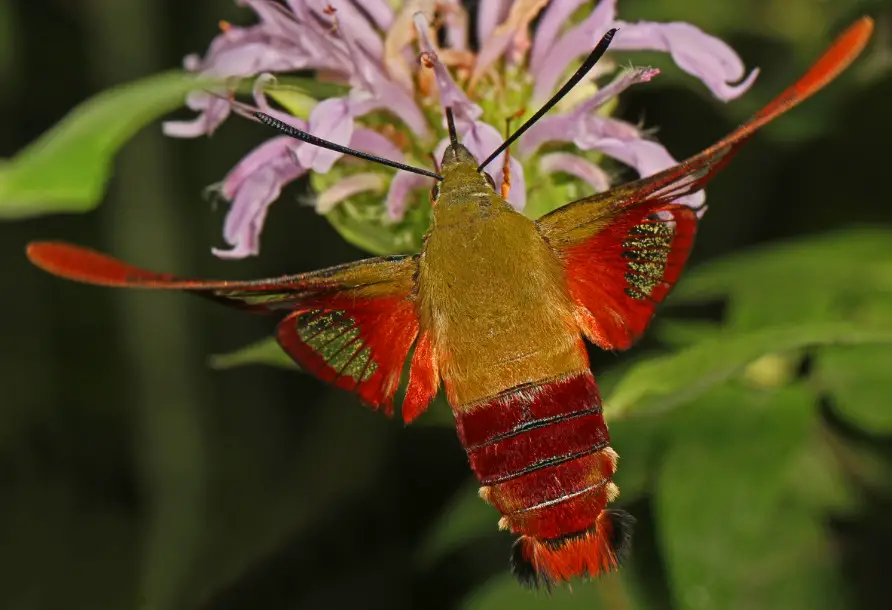
The Hummingbird Clearwing is a diurnal moth that closely resembles a small hummingbird, both in appearance and behavior. It has a wingspan of about 1.5 to 2.5 inches, with a fuzzy olive-green and burgundy body. Its wings are partially transparent (hence “clearwing”) with reddish-brown borders, giving it a unique, glassy look.
This moth is active during the day, particularly in the morning and early evening, and hovers in front of flowers while feeding. It prefers nectar-rich blooms like bee balm, phlox, verbena, and butterfly bush. Its hovering and darting flight patterns, along with the hum of its wings, often confuse observers into thinking they are seeing a hummingbird.
Caterpillars feed on honeysuckle, viburnum, and dogbane, and pupate in the leaf litter during winter. In North Carolina, the Hummingbird Clearwing is very common in flower gardens, open woodlands, and meadows, especially in the Piedmont and Mountain regions where nectar sources are plentiful throughout spring and summer.
Snowberry Clearwing (Hemaris diffinis)
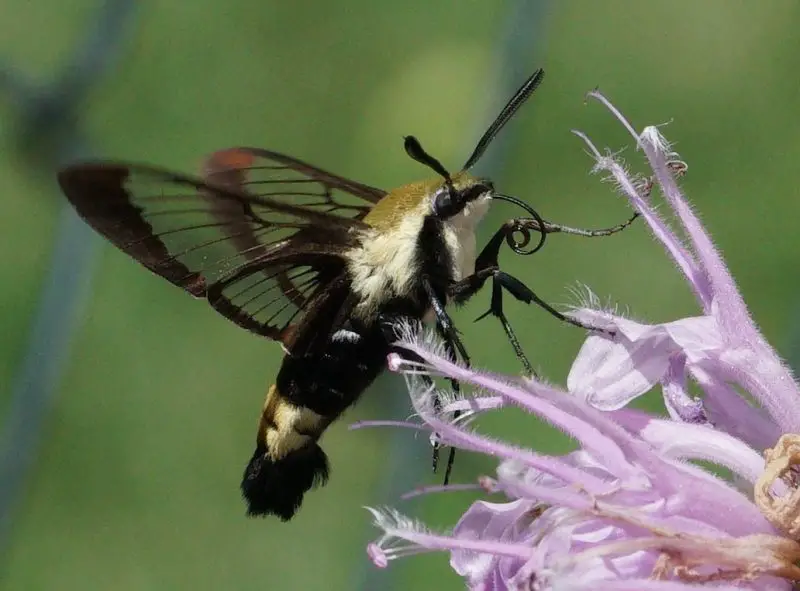
The Snowberry Clearwing is a day-flying moth that strongly resembles a bumblebee, with a fuzzy black and yellow body and transparent wings. It has a wingspan of about 1.5 to 2.2 inches. Its forewings and hindwings are partially clear with narrow brown edges, and it has a black stripe running through the eye, contributing to its bee-like disguise.
Unlike many moths, this species is diurnal and most active during sunny days, particularly from late spring through summer. It hovers in front of flowers while feeding, mimicking both the flight and sound of a hummingbird or bee. This mimicry likely helps deter predators such as birds and lizards. Its movements are quick and darting, often leading observers to misidentify it at first glance.
The larvae feed on plants like honeysuckle, snowberry, and dogbane. The species prefers gardens, meadows, forest edges, and open woodlands. In North Carolina, Snowberry Clearwings are widely distributed, especially in the Piedmont and Mountain regions, where flowering plants and host shrubs are common from late May to early fall.
Imperial Moth (Eacles imperialis)
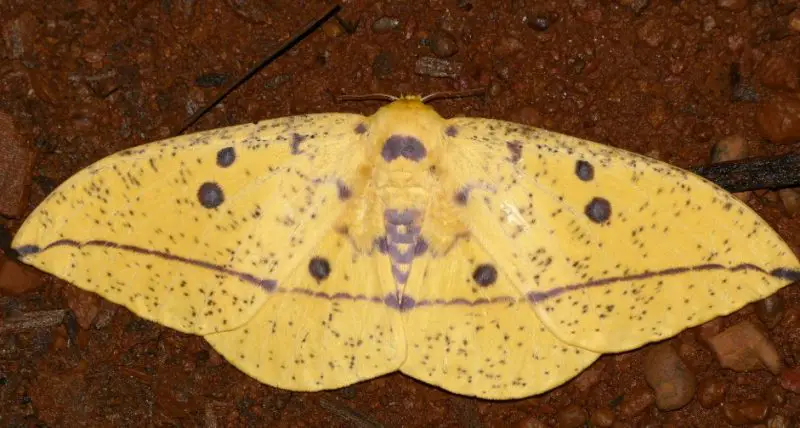
The Imperial Moth is one of the largest and most impressive moths in eastern North America, with a wingspan ranging from 3 to nearly 7 inches. Adults are yellow with variable brownish-purple blotches, giving them a faded, leaf-like appearance. Their sheer size and bold pattern make them a standout among North Carolina moths.
These moths are nocturnal and seen mostly in mid-to-late summer. Males tend to fly more actively at night in search of females, while females remain more stationary. Despite their size, adults do not feed and live for only a short period, focused solely on reproduction. They are often found near lights or resting on trees and siding in suburban and rural areas.
The caterpillars are equally large, growing over 5 inches long, and feed on a wide variety of trees including oak, maple, sweet gum, pine, and sassafras. The species thrives in mature forests and wooded suburban areas. In North Carolina, the Imperial Moth is commonly found in the Coastal Plain and Piedmont regions, especially in places with large, mature trees.
Common Spring Moth (Heliomata cycladata)

The Common Spring Moth is a small, delicate moth that appears early in the year, often signaling the start of the moth season. It has a wingspan of about 0.75 to 1 inch and features yellowish-tan forewings with distinctive brown lines and patches. Its soft coloring blends well into leaf litter and bark.
This species is mostly active during the day and at twilight in early spring, usually from March through May. They flutter low to the ground and are often seen resting on small shrubs or flying among low vegetation. Though not as showy as other moths, their early seasonal activity makes them a reliable sight in gardens and forest understories.
Larvae of the Common Spring Moth feed on low woody shrubs, especially members of the aster family and other herbaceous plants. It prefers edge habitats, brushy fields, and lightly wooded areas. In North Carolina, it is frequently observed in early spring across the state, particularly in the Piedmont and lower Mountain regions.
Clymene Moth (Haploa clymene)
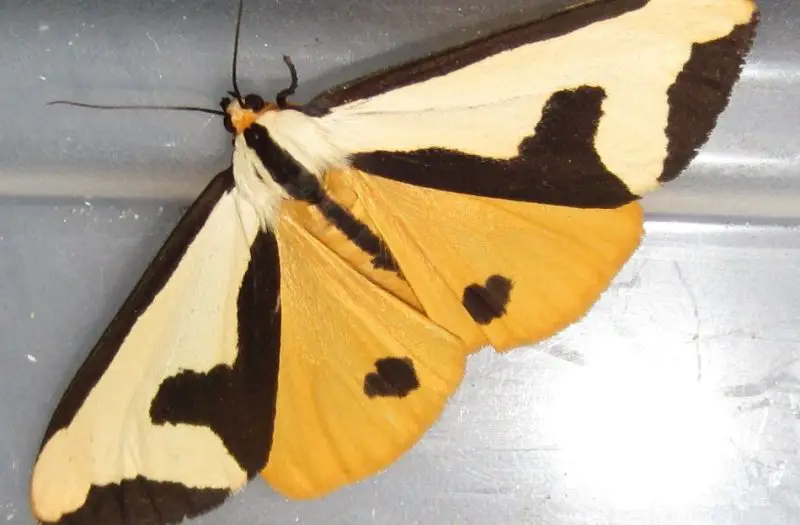
The Clymene Moth is easily recognized by its striking wing pattern—a creamy white base color with a bold black cross or T-shaped mark on each forewing. Its wingspan ranges from 1.5 to 2 inches. When at rest, its wings are held flat, revealing the dramatic contrast that serves as a warning pattern to potential predators.
This moth is nocturnal and commonly seen near porch and street lights in mid to late summer. Though not a frequent garden visitor, it is drawn to artificial light sources and sometimes rests on walls or tree trunks during the day. Adults are short-lived and focused on mating and reproduction, not feeding.
Caterpillars feed on various plants including eupatoriums, oaks, and willows. They prefer meadows and forest edges, particularly where their host plants grow in partial shade. In North Carolina, Clymene Moths are found throughout the state, particularly in the Piedmont and Coastal Plain during warm, humid months.
Harnessed Tiger Moth (Apantesis phalerata)
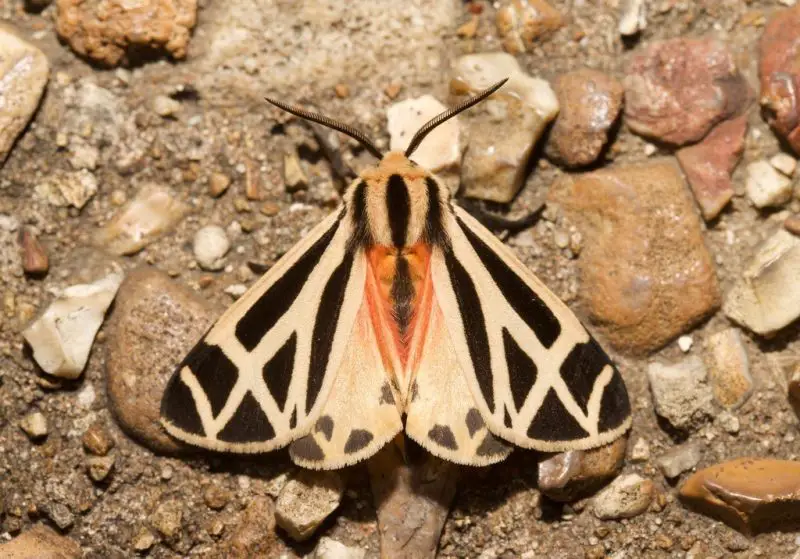
The Harnessed Tiger Moth is a vividly patterned species, with striking black-and-yellow striped forewings and bright pinkish-orange hindwings marked with dark spots. Its wingspan is about 1.2 to 1.6 inches. This moth gets its name from the “harness-like” pattern of its forewings, which resembles a grid of narrow bands.
It is active at night and is frequently seen in mid-to-late summer, particularly around outdoor lights. The colorful hindwings are usually hidden at rest and only revealed when the moth is disturbed, serving as a flash display to startle predators. This moth belongs to the tiger moth group, known for their bold patterns and nocturnal habits.
The larvae, often called woolly bears, feed on a wide range of herbaceous plants including clover, dandelions, and plantains. They are commonly found in gardens, meadows, and roadside vegetation. In North Carolina, the Harnessed Tiger Moth is widespread and most abundant in the Piedmont and Coastal Plain regions, particularly during warm, moist months from June through September.
Red-fringed Emerald (Nemoria bistriaria)
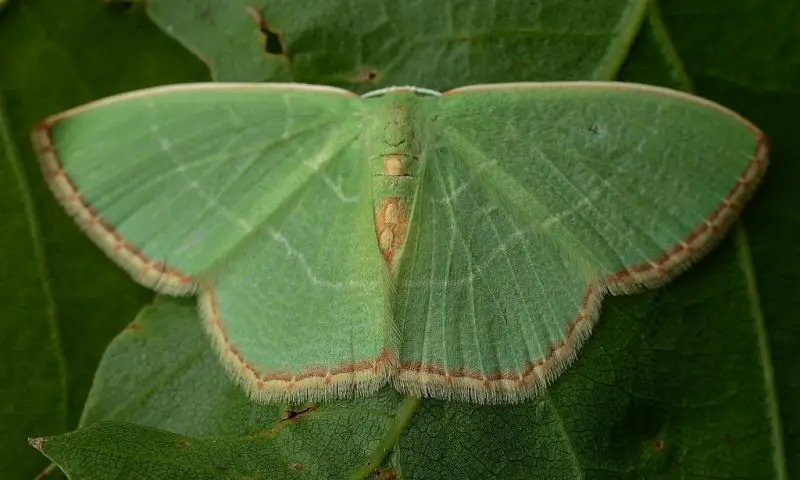
The Red-fringed Emerald is a small but eye-catching moth in the Geometridae family, known for its bright green wings edged with a narrow red border. Its wingspan ranges from about 0.75 to 1 inch. The vivid emerald green coloring provides effective camouflage among foliage, while the red fringe gives it a distinctive and elegant appearance.
This moth is nocturnal and most active during late spring and summer. It is attracted to lights and can occasionally be seen resting on leaves or window screens. Like many geometrid moths, adults have slender bodies and hold their wings flat when at rest. Their subtle beauty often goes unnoticed unless closely observed under good lighting.
Larvae feed on a variety of deciduous trees and shrubs, including oak, blueberry, and dogwood. The Red-fringed Emerald prefers woodland edges, gardens, and shrubby areas where host plants are common. In North Carolina, it is most frequently encountered in the Piedmont and Mountain regions during warm months.
Wavy-lined Emerald (Synchlora aerata)
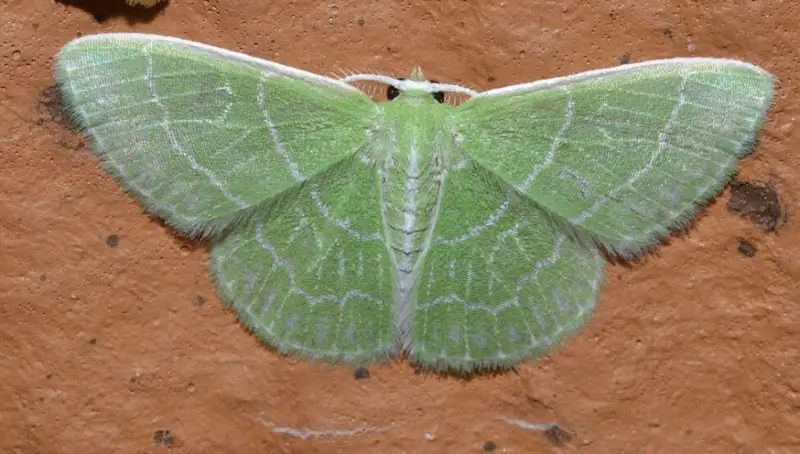
The Wavy-lined Emerald is a delicate, pale green moth with narrow, wavy white lines running across its wings. It has a wingspan of about 0.6 to 0.9 inches. The green coloration blends seamlessly with vegetation, making it difficult to detect when resting on leaves or stems.
Adults are nocturnal and typically seen from spring through early fall. One of the most fascinating features of this species is its larva’s camouflage technique: caterpillars attach bits of plant material to their backs, disguising themselves as pieces of debris or flowers. This makes them nearly invisible to predators and curious observers alike.
The larvae feed on a wide variety of flowering plants, including aster, goldenrod, and daisy species. Wavy-lined Emeralds thrive in gardens, meadows, and open woodland areas. In North Carolina, they are widespread and most often spotted in the Coastal Plain and Piedmont regions, particularly in late summer when flowers are abundant.
Frosted Dagger Moth (Acronicta hastulifera)

The Frosted Dagger Moth is a medium-sized species with grayish wings marked by black streaks and frost-like patterns, giving it a somewhat icy or speckled appearance. It has a wingspan of 1.2 to 1.6 inches. Its muted coloration provides excellent camouflage against tree bark and weathered wood.
Though related to the more common American Dagger Moth, the Frosted Dagger is encountered less frequently. Adults are nocturnal and most active during midsummer. They are drawn to light but often go unnoticed due to their cryptic coloring and less frequent urban sightings.
The larvae feed on a variety of hardwood trees, such as oak, birch, and maple. The species favors mature forests, especially those with moist understory and mixed tree composition. In North Carolina, the Frosted Dagger Moth has a scattered distribution but is primarily found in wooded areas of the Piedmont and Mountain regions.
Pine-devil Moth (Citheronia sepulcralis)
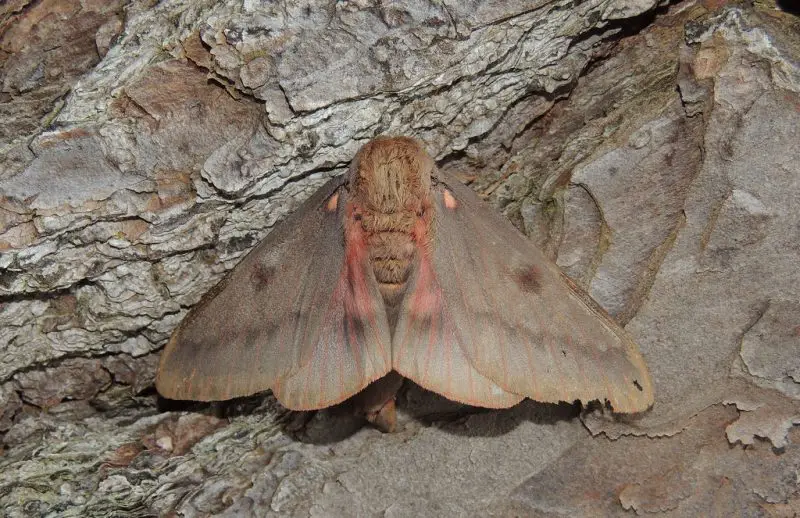
The Pine-devil Moth is a striking and rarely seen moth that belongs to the same family as the Regal Moth. It has a wingspan of 3 to 4.5 inches and features dark brown wings with subtle grayish markings and orange tones on its body. Its robust build and muted coloration distinguish it from its brighter cousins.
This species is strictly nocturnal and more secretive than other large moths. Adults are most active during midsummer and are rarely seen unless drawn to lights near pine forests. They are slow flyers but tend to remain hidden during the day, resting in foliage or on tree bark.
The caterpillars are large and feed primarily on pine needles, especially those of loblolly and longleaf pines. The Pine-devil Moth is closely tied to pine-dominated habitats. In North Carolina, it is mostly found in the Coastal Plain and Sandhills, where mature pine forests provide the necessary conditions for larval development.
Ilia Underwing (Catocala ilia)
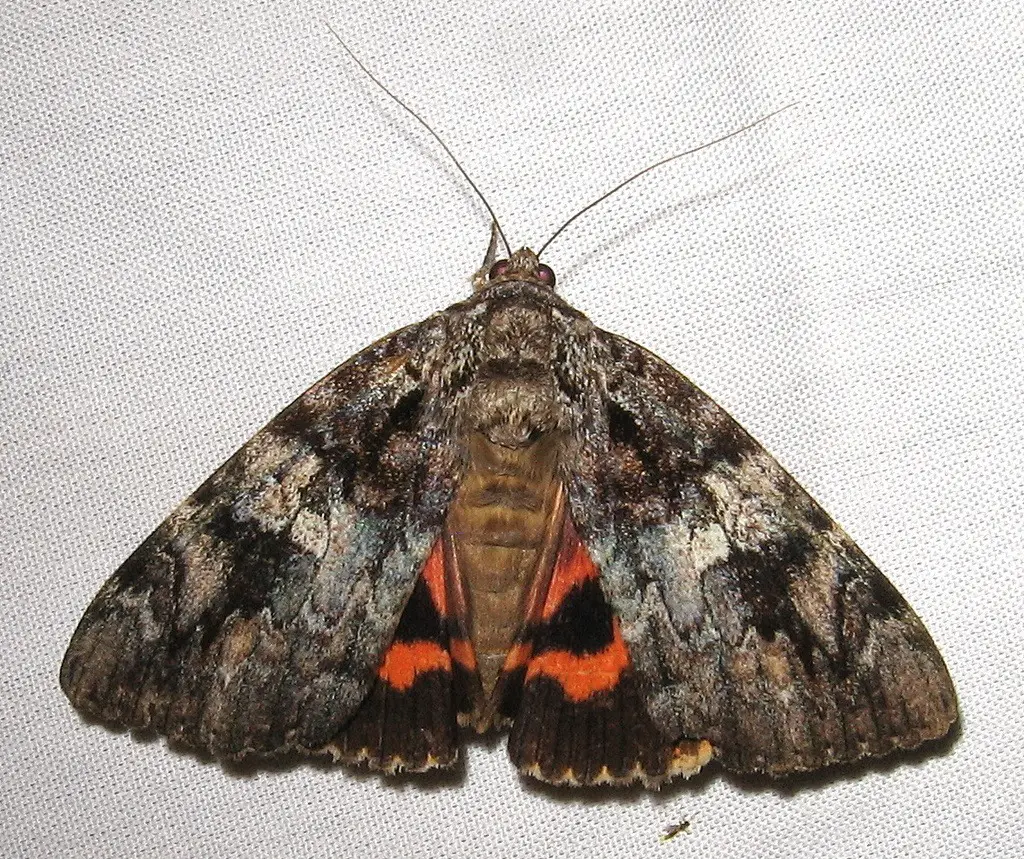
The Ilia Underwing is a beautiful and dramatic moth with cryptic forewings and vivid hindwings. Its forewings are mottled gray and brown, resembling tree bark, while the hindwings are a striking orange or reddish-orange with black bands. It has a wingspan of 2 to 3 inches, making it one of the more noticeable underwings when disturbed.
These moths are nocturnal and typically stay motionless during the day, blending into bark or shaded surfaces. When startled, they flash their bright hindwings as a defense mechanism to confuse or scare predators, then quickly drop into flight. Their ability to vanish into the background once they land again adds to their elusive nature.
Larvae feed on various species of oak, which are abundant throughout North Carolina. The Ilia Underwing prefers oak-dominated woodlands, suburban areas with mature trees, and natural forests. It is found across the state, especially in the Piedmont and Mountain regions during the warm summer months, from June through September.
Banded Tussock Moth (Halysidota tessellaris)
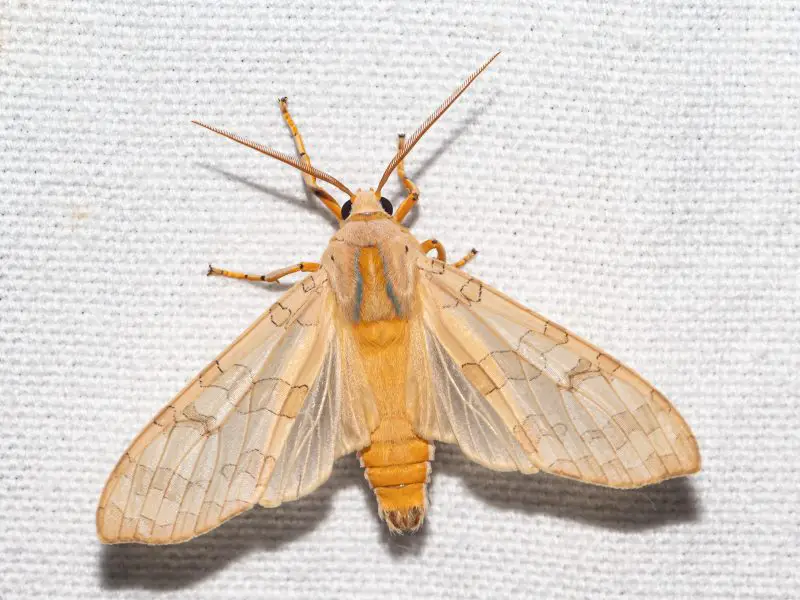
The Banded Tussock Moth is a fuzzy, light gray moth with subtle patterns of darker gray or brown on its wings. It has a wingspan of about 1.5 to 2 inches. Its body and wings are covered in dense, soft hairs, giving it a velvety appearance. The subtle coloration helps it blend in with tree bark and leaves.
Adults are nocturnal and typically appear from late spring through summer. They are often seen near lights or resting on flat surfaces like walls and tree trunks. While the adult moth is not harmful, its caterpillar stage is well known for its fuzzy appearance, with long tufts of hair that can sometimes cause mild skin irritation in sensitive individuals.
The larvae feed on a wide variety of hardwood trees, including oak, birch, walnut, hickory, and sycamore. Though they are not considered major pests, high populations can cause minor defoliation in urban and forest settings. In North Carolina, the Banded Tussock Moth is widespread and most commonly observed in the Piedmont and Mountain regions.
Evergreen Bagworm Moth (Thyridopteryx ephemeraeformis)
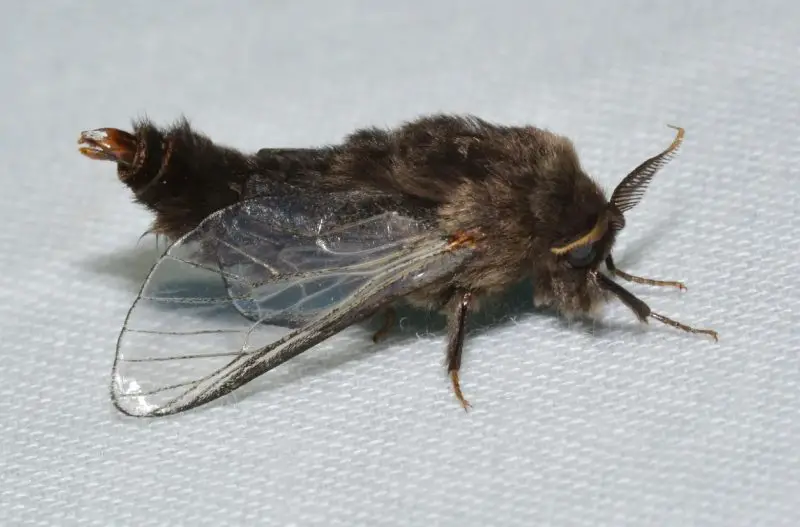
The Evergreen Bagworm Moth is best known not for its appearance as an adult, but for the peculiar case or “bag” its larvae construct. The adult female is wingless and never leaves her bag, while the male has blackish wings and a feathery antenna, flying only to mate. The moth’s presence is most obvious during the larval stage when the bags hang from branches like tiny pinecones.
Larvae create their protective bags out of silk and bits of foliage, attaching them to tree branches. The caterpillars feed from within these cases, gradually enlarging them as they grow. Severe infestations can lead to noticeable defoliation, especially on small conifers and ornamental shrubs.
Bagworms feed on many evergreens, including arborvitae, juniper, cedar, and pine. They are also known to attack deciduous trees. In North Carolina, this species is a common pest in landscaped areas, suburban yards, and nurseries—especially in the Piedmont and Coastal Plain—where ornamental evergreens are frequently planted.
Fall Armyworm Moth (Spodoptera frugiperda)
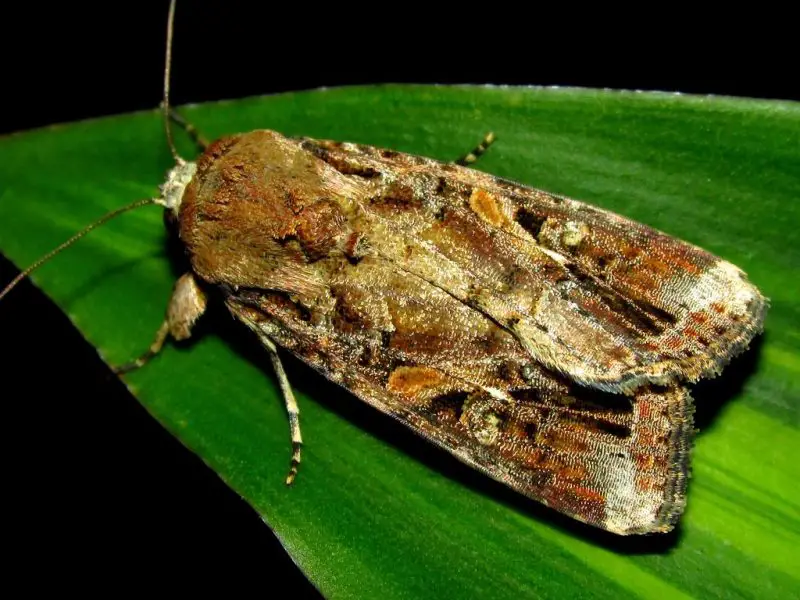
The Fall Armyworm Moth is a rather plain, grayish-brown moth with a wingspan of about 1.3 to 1.6 inches. Its forewings are mottled with subtle brown and tan patterns, while the hindwings are lighter with a thin dark margin. Though the adult moth is inconspicuous, its larval stage is one of the most destructive agricultural pests in the southeastern U.S.
Adult moths are nocturnal and capable of migrating long distances. Females can lay hundreds of eggs on grasses and crop plants, which hatch into hungry caterpillars that travel in “armies” to feed on foliage. Outbreaks typically occur in late summer and early fall, especially following warm, wet conditions.
The larvae feed on a wide variety of crops, including corn, sorghum, grasses, and vegetables. In North Carolina, the Fall Armyworm is a significant concern in agricultural areas throughout the Coastal Plain and Piedmont. Timely management is critical to preventing widespread damage during the growing season.
Purple Longhorn Moth (Adela caeruleella)
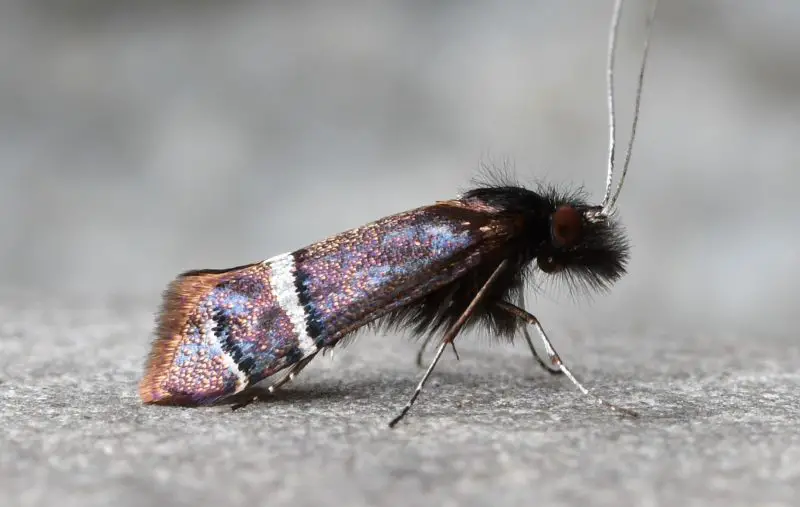
The Purple Longhorn Moth is a tiny, jewel-like moth with metallic purple or blue wings and extremely long antennae—often two to three times the length of its body in males. The wingspan is about 0.3 to 0.5 inches, making it one of the smallest yet most visually striking moths in the region.
This moth is diurnal and most active in early summer, particularly around late May to June. It flits among wildflowers during daylight hours, often mistaken for a type of fly due to its quick, hovering flight and small size. The long antennae wave rhythmically in the air, making it especially noticeable when perched.
Larvae feed on the decaying flowers and foliage of herbaceous plants, especially asters and goldenrods. Adults prefer meadows, woodland clearings, and roadsides filled with blooming wildflowers. In North Carolina, the Purple Longhorn Moth is widespread but often overlooked due to its small size—most commonly spotted in the Piedmont during the early summer bloom.
Peach Tree Borer (Synanthedon exitiosa)
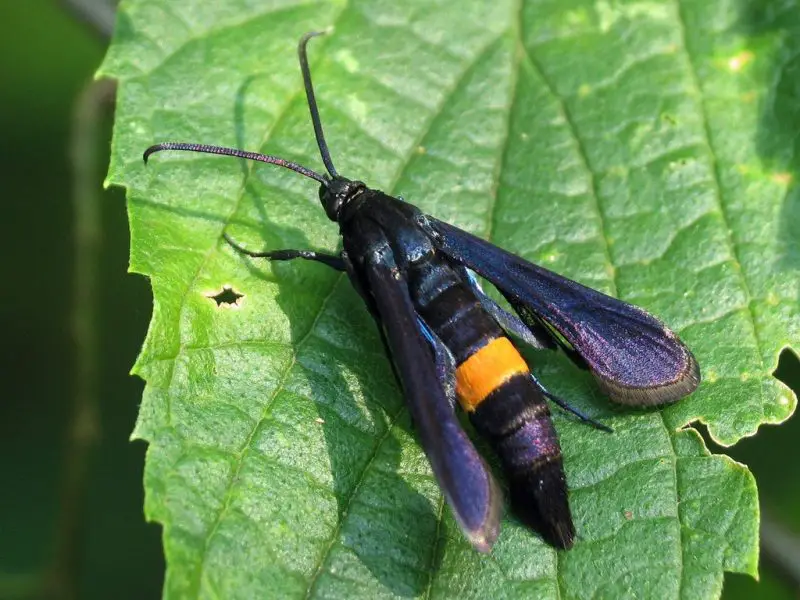
The Peach Tree Borer is a clearwing moth that mimics a wasp in both appearance and behavior. Females have a glossy dark blue-black body with an orange band across the abdomen, while males are smaller with additional yellow striping. With a wingspan of 1 to 1.5 inches, its clear wings and fast, buzzing flight help it avoid predation.
Adults are active during the day, particularly from late spring through summer. They do not sting, but their mimicry makes them resemble aggressive insects like hornets. The female lays eggs at the base of stone fruit trees, where larvae tunnel into the bark and roots, feeding on the cambium layer.
This species is a serious pest of fruit trees including peach, plum, cherry, and apricot. Damage typically occurs near the soil line and can girdle trees if left unmanaged. In North Carolina, the Peach Tree Borer is common in orchards and home gardens, especially in the Piedmont and Coastal Plain where fruit tree cultivation is widespread.
Squash Vine Borer (Carmenta bassiformis)
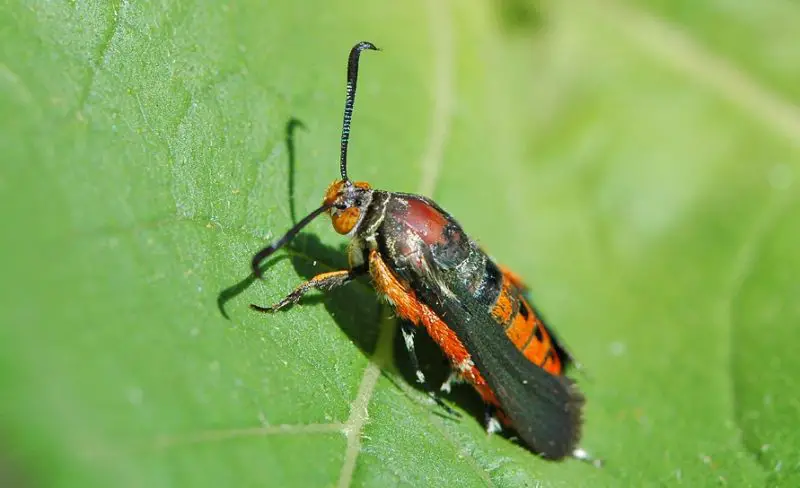
The Squash Vine Borer is a day-flying moth that closely resembles a wasp, with a slender orange and black-striped body and narrow, partially transparent wings. It has a wingspan of about 1 to 1.5 inches. Its mimicry helps it avoid predators, making it a deceivingly dangerous insect in vegetable gardens.
Unlike most moths, adults are active during the daytime, especially in midsummer. They are often seen flying low and rapidly around squash plants, where females lay eggs near the base of the stems. After hatching, the larvae bore directly into the vines of squash, zucchini, and pumpkins, often causing the plant to wilt suddenly and die from internal damage.
The larvae feed within the stems, making them difficult to detect until it’s too late. Frass (sawdust-like waste) near the base of the plant is a telltale sign of infestation. In North Carolina, Squash Vine Borers are a major concern for home gardeners and small farms throughout the Piedmont and Coastal Plain, where cucurbits are widely grown in the summer months.
Grape Leaffolder (Desmia funeralis)
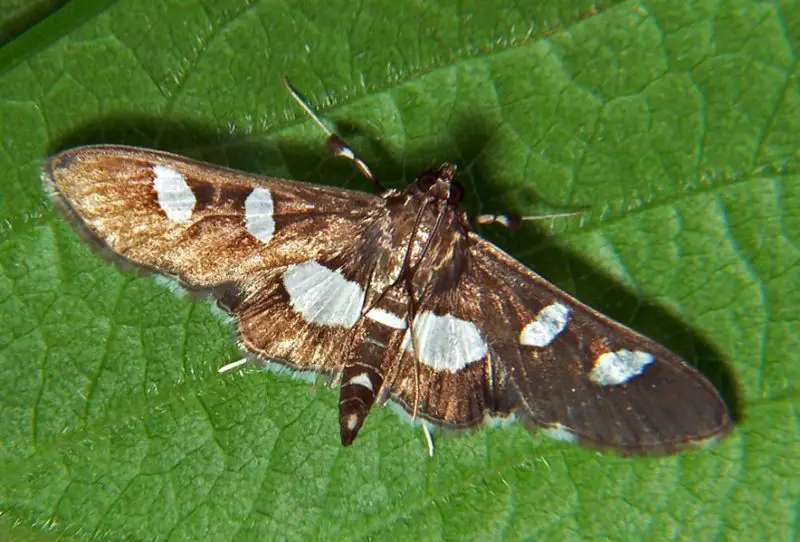
The Grape Leaffolder is a small, dark moth known for its velvety black wings bordered with bright white spots or bands. It has a wingspan of about 1 to 1.3 inches. The bold contrast in its wing pattern makes it relatively easy to identify when resting with its wings spread open.
This species is nocturnal and most active from late spring through fall. Adults are drawn to light and often go unnoticed unless caught in traps or spotted during nighttime observation. The larvae are more conspicuous, as they fold or roll grape leaves and secure them with silk, feeding within the shelter they create.
The caterpillars feed primarily on grapevines but can also be found on Virginia creeper and other related plants. While they typically cause only cosmetic damage, high populations can reduce foliage and affect fruit production. In North Carolina, the Grape Leaffolder is widespread in vineyards, backyard gardens, and forest edges where wild grapes grow, especially in the Piedmont and Coastal regions.
Bold-feathered Grass Moth (Herpetogramma pertextalis)
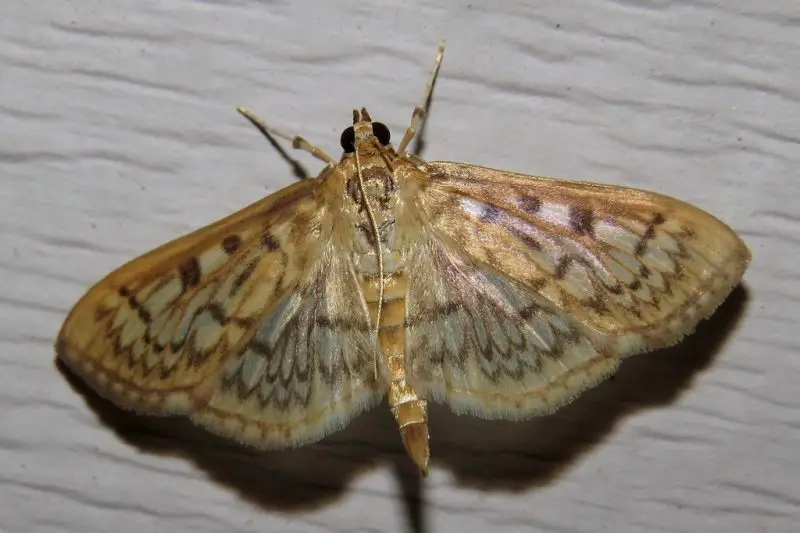
The Bold-feathered Grass Moth is a modestly sized moth with light brown or tan wings, subtly marked with darker brown lines and spots. It has a wingspan of about 1 to 1.2 inches. Though its appearance is not flashy, its finely detailed wing patterns and faint “feathered” lines make it quite beautiful upon close inspection.
This moth is nocturnal and is typically seen during the summer months. It is attracted to lights and is often found near grassy fields, weedy edges, and shrublands. The adults rest low on vegetation or walls during the day and fly actively at night.
The larvae feed on grasses and low-growing herbaceous plants, including crops and weeds. They are generally not considered serious pests but may contribute to localized leaf damage in high numbers. In North Carolina, the Bold-feathered Grass Moth is commonly encountered in the Coastal Plain and lower Piedmont, particularly in areas with open meadows, roadsides, and grassy woodland margins.






